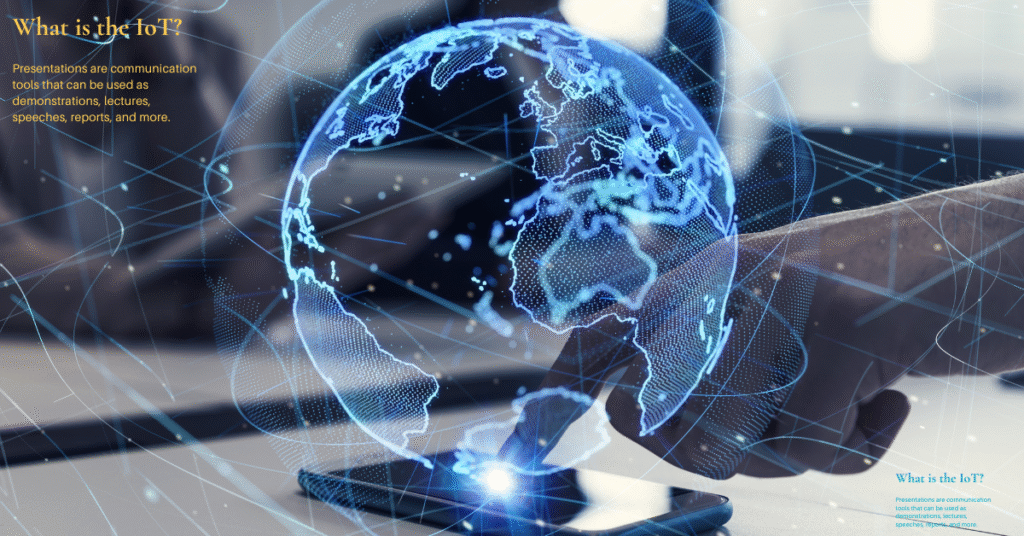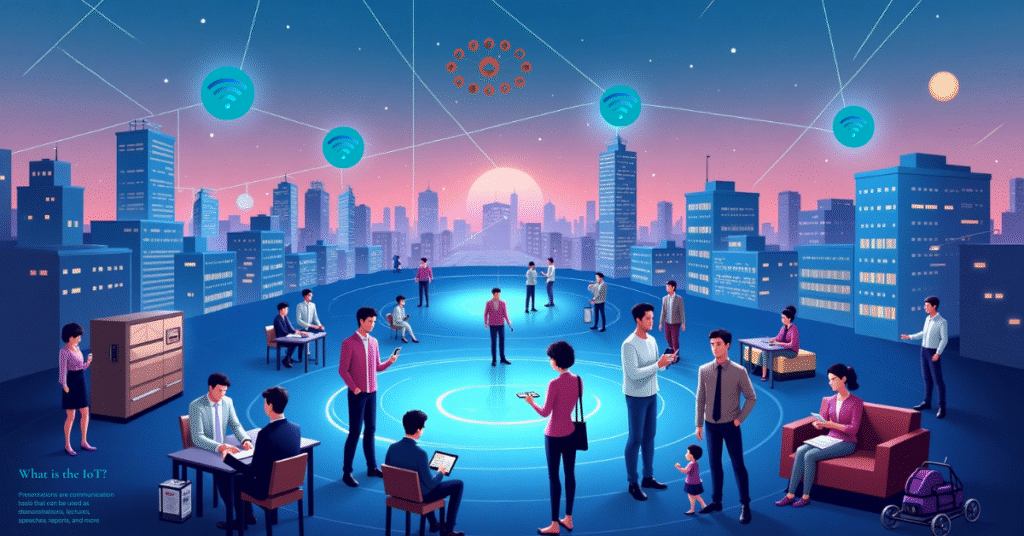Introduction
Imagine a house that follows your orders, prepares your favorite coffee, and alerts you about your schedule even in the absence of explicit commands. This is not a figment of an author’s imagination, but an example of the Internet of Things (IoT). The pace of the modern technological evolution, where IoT stands as a key domain, is the one turning the world’s state of the art, not only in the field of works but also materials, and daily life, through the connection of stuff, the collection of data as well as the realization of intelligent automation – the so-called the internet of things.
The Internet of Things (IoT) is a system of physical “things” (devices, sensors, appliances, vehicles, etc.) connected via the Internet to collect and exchange data. These smart objects – from home thermostats and wearable fitness trackers to industrial machines and traffic lights – contain sensors, software, and network hardware that allow them to communicate and act with minimal human intervention. In essence, any object that can be assigned an IP address and send/receive data over a network can become part of the IoT. By linking devices to the cloud and each other, IoT enables remote monitoring, control, and automation of systems, driving efficiency and new functionality across sectors.
IoT works by sensing and communicating data. Sensors embedded in devices (e.g., temperature, motion, heart-rate sensors) continuously collect information about the environment. That data is sent over networks (Wi-Fi, cellular/5G, Bluetooth, LPWAN, etc.) often via an IoT gateway or edge device. In the cloud or on local servers, applications analyze the data to detect patterns or trigger actions. For example, a smart thermostat senses room temperature and automatically adjusts heating, or a factory sensor reports equipment wear so maintenance can be scheduled. Users interact with the system through apps or dashboards (graphical interfaces) to view data and give commands. In this way, IoT auto-magically links the physical world to software: devices do most of the work autonomously, while people set them up and use the insights.
Components of IoT
IoT solutions typically involve several key components:
- Sensors and Actuators: IoT “things” include sensors (to measure data like temperature, motion, light, pressure, biochemical signals, etc.) and actuators (to perform actions like switching a motor or opening a valve). Modern sensors can be very small (thanks to MEMS technology) and can detect almost anything from humidity to heart rate. Actuators respond to processed data (e.g., a valve opening when soil moisture is low) based on rules or analytics.
- Connectivity (Networks & Protocols): Devices connect using various communication technologies. This includes short-range links (Bluetooth, ZigBee, Z-Wave, Wi-Fi) for home or personal networks, and long-range networks (cellular 4G/5G, LoRaWAN, NB-IoT, satellite) for wide-area deployment. Data is sent via standard IoT protocols (like MQTT, HTTP, CoAP) through an IoT gateway or directly to cloud servers. Connectivity choices depend on range, power needs, and bandwidth.
- Data Processing (Cloud/Edge): Collected data is aggregated in cloud platforms or edge servers. There, it is stored, processed, and analyzed using databases, analytics engines, and often AI/machine learning. This processing turns raw sensor data into useful information (alerts, predictions, controls). For example, analyzing vibration data from a machine can predict a failure before it happens. Many IoT systems now use edge computing (local processing on or near the device) to reduce latency and bandwidth use.
- User Interface and Applications: Finally, IoT systems provide interfaces (mobile apps, web dashboards, cloud consoles) so people can monitor and manage devices. These UIs visualize data trends, allow remote control, and trigger notifications or reports. For instance, a mobile app might show your home’s energy use in real time or alert you to a smoke alarm.
Together, these components form an IoT ecosystem: devices/sensors gather data, connectivity links them to gateways, software processes the data, and UIs let humans interact.
Applications of IoT

IoT technologies are used in virtually every sector. Key examples include:
- Smart Homes and Buildings: Thermostats, lights, locks, and appliances that you can monitor and control via phone. For example, smart thermostats adjust heating when you’re away, and smart security cameras alert you to visitors. These increase comfort and save energy. (Fortinet notes IoT spans “smart homes” in its overview.)
- Wearables & Healthcare: Fitness bands, smartwatches, medical monitors, and even implanted devices. Wearables can track steps, heart rate, or sleep quality, while medical IoT (IoMT) devices can monitor blood glucose or alert EMTs in an emergency. Remote patient monitoring via IoT can improve care and reduce hospital stays.
- Industrial IoT (IIoT) and Manufacturing: Sensors on factory equipment monitor performance and trigger predictive maintenance before breakdowns occur. This Industry 4.0 trend includes automated robotics, real-time supply-chain tracking, and smart factories optimizing production. For example, IoT sensors in a machine can predict when parts will fail, minimizing downtime.
- Smart Cities and Infrastructure: Urban IoT includes smart traffic lights that adapt to congestion, waste bins that signal when full, environmental sensors tracking pollution, and networked public transport ticketing. These systems improve city services and resource use. (Victorian Government’s privacy report cites “smart bins” and “networked ticketing” as IoT examples.)
- Agriculture and Environment: Farmers use soil moisture and weather sensors to optimize watering and yields (so-called precision agriculture). Livestock can be tracked with RFID tags. Environmental monitoring (e.g., forest fire sensors, water quality) also uses IoT to gather data from remote locations.
- Retail and Logistics: Stores deploy smart shelves and RFID tags to track inventory in real time. Delivery and logistics companies use GPS and IoT sensors to monitor vehicles and shipments, improving efficiency and reducing loss.
Across these areas, the common theme is real-time data and control. IoT turns ordinary objects into online data sources and actuators, enabling innovations like automated homes, telemedicine, factory automation, and intelligent transportation.
Benefits of IoT
IoT brings many advantages by digitizing physical processes. Key benefits include:
- Increased Efficiency and Productivity: IoT automates routine tasks and streamlines processes. For example, smart factories automatically adjust machine parameters to optimize output, or HVAC systems only run when needed. This reduces energy use and labor costs and minimizes errors. “IoT automates tasks and optimizes processes,” Fortinet notes, leading to higher productivity and reduced costs (e.g., less unplanned downtime in factories)
- Enhanced Automation: IoT enables systems to operate autonomously. Vehicles can use sensor networks to drive themselves; home systems can adjust lighting and climate automatically based on occupancy. For instance, a smart garage can open as your car approaches, and then close after you enter. Such automation improves convenience and safety.
- Better Decision-Making: By collecting rich data, IoT provides insights that inform decisions. Businesses can analyze usage patterns to optimize inventory, prevent maintenance issues, or personalize services. For example, retailers use IoT data to track customer behavior and adjust stock levels accordingly. As Fortinet states, IoT “provides valuable data insights” that lead to more informed decisions.
- New Services and Innovation: IoT enables entirely new applications. Smart appliances can alert you to buy supplies when running low, or industrial sensors can offer new safety features (e.g., alerting drivers to road hazards). In healthcare, continuous monitoring can lead to personalized medicine. In short, IoT’s data-driven feedback loop sparks innovation across products and services.
- Cost Savings: In the long run, IoT can cut costs through reduced waste, preventive maintenance, and energy savings. For instance, by predicting machine failures, companies avoid costly breakdowns and idle time. Smart grids balance electricity loads to prevent outages and lower bills.
Overall, IoT’s automation and data help businesses and consumers be smarter, safer, and more efficient.
Challenges of IoT
Despite its promise, IoT faces several hurdles:
- Security Vulnerabilities: Every connected device is a potential entry point for hackers. Many IoT gadgets have limited built-in security (weak/default passwords, no encryption), so large-scale deployments greatly expand the attack surface. As experts warn, “the more linked devices, the higher the chance of cyber-attacks,”efani.com. Securing IoT requires encryption, authentication, and ongoing updates.
- Privacy Concerns: IoT devices often collect personal and sensitive data (health stats, location, usage patterns). Without strict controls, this can infringe on privacy. For example, smart home cameras or wearables continuously monitor personal activities. If data is mishandled or leaked, it can be abused. Privacy regulators caution that rushing into IoT without safeguards can have “harmful and unexpected consequences” due to massive data collection.
- Interoperability and Standards: Today’s IoT landscape is fragmented. Different vendors use different protocols and formats, so devices may not easily work together. Lack of common standards makes it hard to integrate and scale IoT solutions. Experts note that ensuring interoperability “across devices and platforms without a shared set of standards” is a significant challenge.
- Scalability and Complexity: As IoT networks grow (tens of billions of devices projected), managing them becomes complex. Tasks like device provisioning, firmware updates, and data management at scale are nontrivial. Also, collecting and storing huge data volumes strains networks and cloud resources. Scaling up an IoT system requires robust infrastructure and planning.
- Energy and Connectivity Limitations: Many IoT devices run on batteries or solar power (think remote sensors), so energy efficiency is critical. Long battery life often means low-power communication protocols, which may limit data rates. Additionally, ensuring reliable connectivity in rural or remote areas can be hard. A stable network is required for many real-time IoT applications, so coverage gaps or outages pose problems.
- Cost: Although component prices are falling, deploying IoT at scale still involves significant investment in hardware, software, and integration. Small organizations may find the initial costs of sensors, networks, and analytic tools prohibitive.
Overcoming these challenges involves improved security practices, industry collaboration on standards, and innovative technologies (see below).
Future Trends in IoT

Looking ahead, several trends are shaping IoT’s evolution:
- AI and Edge Computing Integration: Artificial intelligence will increasingly be embedded in IoT devices. Combining AI with edge computing means devices can analyze data locally for real-time insights (e.g., predictive maintenance, anomaly detection). This reduces latency and bandwidth use, enabling faster responses. For example, a factory sensor with on-board AI can identify a fault immediately, without waiting for cloud analysis.
- Advanced Connectivity (5G and LPWAN): Next-generation networks will connect more devices at higher speeds. 5G offers very low latency and high throughput, ideal for autonomous vehicles and remote surgery. At the same time, Low-Power Wide-Area Networks (LPWANs like LoRaWAN and NB-IoT) allow low-energy, long-range connections for billions of sensors. Analysts project over 30 billion IoT devices by 2025, with LPWAN as a key enabler in agriculture, smart cities, and industry.
- Enhanced Security Solutions: As IoT grows, security technologies are advancing. AI-driven security (such as machine-learning intrusion detection) is emerging to protect IoT networks. Standards and certifications are also being developed to improve device security. Expect more robust encryption, hardware security modules, and network monitoring specifically designed for IoT.
- Industry 4.0 and Sector-Specific IoT: IoT will deepen its impact in sectors like manufacturing (Industrial IoT) and healthcare. Smart factories (with fully automated, sensor-driven lines) and remote patient monitoring (continuous health data via wearables) are becoming mainstream. Smart home ecosystems will mature too, with better interoperability standards so devices from different brands work together seamlessly.
- Sustainability and Energy Management: IoT will play a key role in green technologies. Smart grids use IoT to balance the supply and demand of electricity, and IoT sensors monitor resource use (water, energy) to reduce waste. New low-power chips and non-volatile memory designs are also extending the battery life of devices.
- Data Analytics and Big Data: The explosion of IoT data (projected to be tens of zettabytes) will drive advanced analytics. Machine learning on IoT data will uncover trends for businesses. As one forecast noted, by 2030 the global IoT market could exceed $3 trillion, fueled by data-driven services.
Final Thought
IoT is moving toward a more connected, intelligent, and automated future. Growth in AI, networking, and hardware technology will make IoT systems faster, smarter, and more secure than ever before.

No responses yet